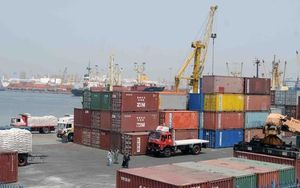Vietnamese businesses are poised to seize growing opportunities in Chile, especially in the processing and export of agricultural products, thanks to favorable free trade agreements and tax incentives. This was highlighted by Ho Thi Quyen, deputy director of the Investment and Trade Promotion Center of Ho Chi Minh City (ITPC), during a workshop titled “Promoting trade and investment in the Chilean market and South America,” held on April 22, 2025, in Ho Chi Minh City.
As the global economy continues to integrate, Quyen emphasized that expanding markets, diversifying trade partners, and attracting investment are crucial for both Vietnam and Ho Chi Minh City. Chile, recognized for its dynamic economy and open trade policies, stands out as a significant partner for Vietnam in South America. The two nations solidified their economic relationship by signing the Vietnam-Chile Free Trade Agreement (VCFTA) in 2014, and both are members of the Comprehensive and Progressive Agreement for Trans-Pacific Partnership (CPTPP). This legal framework enhances bilateral cooperation and facilitates trade.
In 2024, bilateral trade between Vietnam and Chile reached nearly $1.8 billion, with Vietnam exporting around $1.4 billion worth of goods while importing approximately $330 million. Vietnam is now the 12th-largest supplier of goods to Chile and ranks fourth among Asian exporters, trailing only China, Japan, and South Korea. Quyen noted that Vietnam’s main exports to Chile include seafood, coffee, rice, and cement.
Chile's attractiveness as an investment destination is bolstered by its transparent business environment, stable policies, and robust economic growth. In 2024, Chile attracted over $15.3 billion in foreign direct investment (FDI), primarily in sectors such as energy, mining, and global services. However, Chilean investment in Vietnam remains relatively modest, with only four active projects totaling $295,000 in registered capital as of April 2024.
Despite the current figures, there is significant potential for growth. In 2024, Ho Chi Minh City’s exports to Chile were estimated at $53.3 million, indicating room for enhanced bilateral cooperation. Bui Hoang Yen, head of the Southern Trade Promotion Office under the Ministry of Industry and Trade, pointed out that free trade agreements (FTAs) have been instrumental in driving trade growth. Vietnam’s export turnover to Chile has surged by approximately 200% since the VCFTA was implemented.
However, the utilization of preferential certificates of origin (C/O) under Vietnam’s FTAs varies significantly across markets. In 2023, the VCFTA recorded a utilization rate of 40.9%, while the CPTPP saw a mere 6.3% for exports to member countries. Yen also identified potential areas for cooperation with Chile that align with Vietnam’s economic goals, including green energy, mining, high-tech industries, digital transformation, and smart agriculture.
Yet, challenges persist. Businesses face high logistics costs, long transit times, and stiff competition from Chile's multiple FTAs. Addressing these issues will require greater investments in technology, improved management systems, and stronger policy and market support. Pablo Arancibia Salazar, trade representative of ProChile, pointed out that Vietnam’s total export volume to the South American bloc, which includes Brazil, Chile, Argentina, and Colombia, remains limited. He encouraged Vietnamese enterprises to diversify their export products and stabilize their raw material supply chains.
Chile is positioning itself as a strategic investment hub in South America, offering Vietnamese companies opportunities in sectors such as seafood, wood processing, and clean energy. The country not only serves as a trade gateway but also as a strategic partner for expanding into South America, a region boasting a combined GDP of $4 trillion and a population of 431 million.
To fully realize this potential, trade promotion agencies from both countries are encouraged to regularly host business matchmaking events, share market intelligence, and assist Vietnamese firms in finding strategic partners. This collaborative approach could pave the way for Vietnamese enterprises to tap into the vast South American market.
Meanwhile, in the context of Vietnam's seafood sector, the industry is grappling with the implications of a new 10% import tariff imposed by the United States on Vietnamese goods. Le Hang, deputy general secretary of the Vietnam Association of Seafood Exporters and Producers (VASEP), cautioned that around 25,000 tonnes of seafood scheduled for export to the US between April and May 2025, alongside 29,500 tonnes already under contract, will be directly impacted by this tariff.
Previously, a $500,000 shrimp shipment faced a 5% tax, amounting to $25,000, but this will now double due to the new tariff. The annual export turnover to the US market is around $2 billion, representing one-fifth of Vietnam's total seafood export value. Key products such as shrimp account for 20%, basa fish for 25%, and tuna for over 40% of this figure.
More than 400 Vietnamese companies are currently exporting or planning to export seafood to the US, with large and high-value orders at stake. Ho Quoc Luc, chairman of Sao Ta Food JSC, one of Vietnam's top five shrimp exporters, expressed concerns about the new tax’s impact on achieving the company’s targets for 2025, indicating that it may necessitate a shift in operational strategy.
Godaco Seafood JSC, another major player in the sector, has eight factories and 30 farming zones with a processing capacity of 40,000 tonnes per year. The company aims to maintain an export turnover of approximately $100 million in 2025, despite the challenges posed by the new tariff.
In light of these developments, the Vietnamese government is advocating for negotiations with the US to establish a more favorable timeline for implementing new import tariffs. They are also urging for a reduction in tariffs to a more manageable level, emphasizing that agricultural and aquatic products are essential consumer goods. The government suggests that the US consider adjusting tariffs in line with American consumers' income.
As the seafood sector faces these hurdles, it is clear that Vietnamese enterprises must adapt and innovate to thrive in the evolving global market, particularly in light of the opportunities presented by Chile and other international partners.




